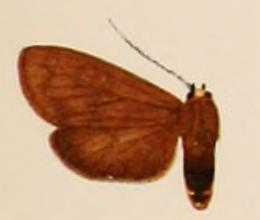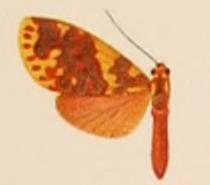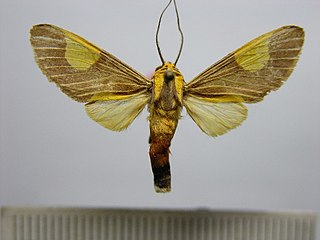
Ochrodota is a genus of moths in the family Erebidae.

Trichromia is a genus of moths in the family Erebidae erected by Jacob Hübner in 1819. The members of this genus are largely indigenous to South America.

Tricypha pseudotricypha is a moth of the subfamily Arctiinae first described by Rothschild in 1909. It is found in French Guiana, Suriname, Amazonas and Peru.

Tricypha nigrescens is a moth of the subfamily Arctiinae first described by Rothschild in 1909. It is found in French Guiana, Brazil and Paraguay.

Trichromia persimilis is a species of moth from the family Erebidae first described by Walter Rothschild in 1909. It is found in French Guiana, Brazil, Peru and Suriname.
Araeomolis irregularis is a moth of the family Erebidae. It was described by Walter Rothschild in 1909, originally under the genus Idalus. It is found in French Guiana and the Brazilian state of Amazonas.
Coiffaitarctia ockendeni is a moth of the family Erebidae first described by Walter Rothschild in 1909. It is found in French Guiana, Suriname, the Amazon region, Peru and Bolivia.

Pseudepimolis incisa is a moth of the family Erebidae. It was described by Walter Rothschild in 1909. It is found in Costa Rica, French Guiana, Brazil, the upper Amazon region, Venezuela and Bolivia.

Hyperthaema hoffmannsi is a moth of the subfamily Arctiinae. It was described by Rothschild in 1909. It is found in Brazil and French Guiana.

Zatrephes miniata is a moth of the family Erebidae. It was described by Walter Rothschild in 1909. It is found in Brazil (Amazonas) and French Guiana.
Ochrodota affinis is a moth of the subfamily Arctiinae first described by Rothschild in 1909. It is found in Brazil.
Ochrodota atra is a moth of the subfamily Arctiinae first described by Rothschild in 1909. It is found in Peru.
Ochrodota brunnescens is a moth of the subfamily Arctiinae first described by Rothschild in 1909. It is found in French Guiana, Suriname and the Brazilian state of Amazonas.
Ochrodota constellata is a moth of the subfamily Arctiinae first described by Paul Dognin in 1909. It is found in Brazil.
Ochrodota tessellata is a moth of the subfamily Arctiinae first described by Rothschild in 1909. It is found in Brazil and Peru.
Ochrodota grisescens is a moth of the subfamily Arctiinae first described by Hervé de Toulgoët in 1999. It is found in French Guiana.
Pseudalus aurantiacus is a moth in the subfamily Arctiinae. It was described by Rothschild in 1909. It is found in Suriname, French Guiana, Brazil and Venezuela.
Pseudalus salmonaceus is a moth in the subfamily Arctiinae. It was described by Rothschild in 1909. It is found in Peru, French Guiana, Venezuela and Ecuador.

Rhipha persimilis is a moth in the family Erebidae. It was described by Walter Rothschild in 1909. It is found in Costa Rica, French Guiana, Ecuador and Peru.
Trichromia klagesi is a moth in the subfamily Arctiinae. It was described by Rothschild in 1909. It is found in French Guiana, Guyana and Brazil.





